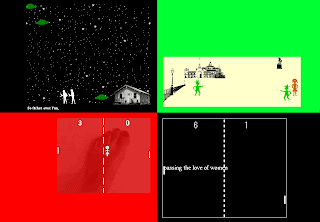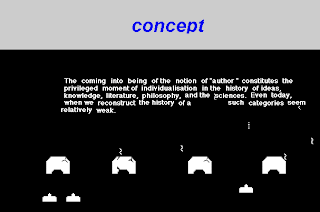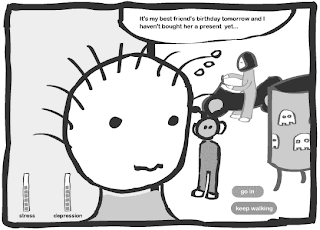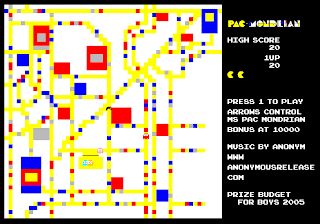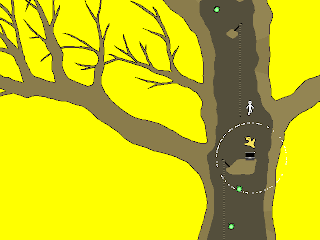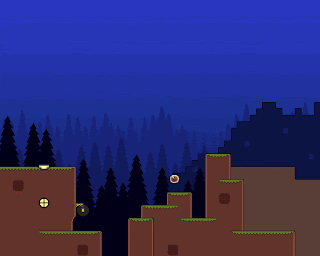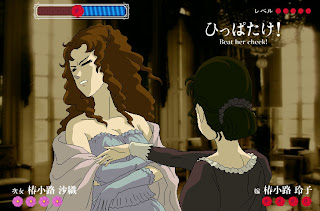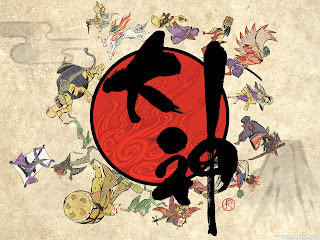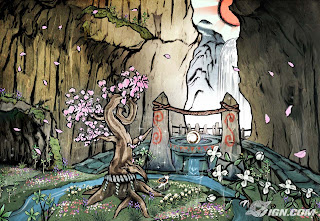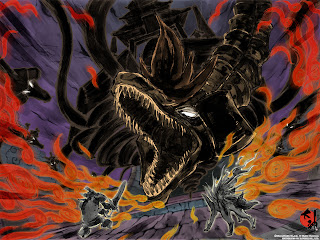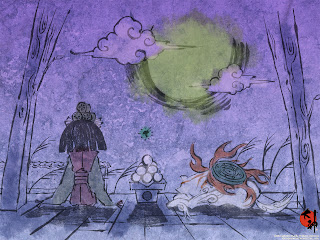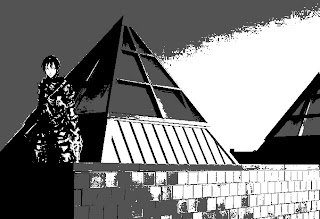When I think of art that has influenced me most, it is generally work done by individuals. I can't recall the last time a corporation created a brilliant painting. I find that this also tends to be true in the emerging area of art games. Individuals are not generally driven to create purely for profit, and have more leeway to experiment and create according to their own artistic vision.
I thought it was time to compile a "best of" list for art games, because there has only been one other such list that I recall online. I'm sure someone will correct me on that point if there has been in fact another well drafted list somewhere out there. The first list can be found in an article on Artifical.dk, titled Art Games - Artificial's List [...]. I thought that Kristine Ploug had done a great job with her articles, though the list did leave out a number of titles which I thought should have been included.
This was also about two years ago, and since then more art games have surfaced. In the meantime, some of the games are no longer accessible, which is the unfortunate reason for why I could not include or rate them here. The creations of Geoffrey Thomas (i.e. Left to My Own Devices) cannot be played anymore. Torrent Raiders is still available for download, but I had the game crash on me every time, which renders it unplayable. Last but not least, a collection of mods of games and engines used as art is still up at Selectparks.net, though most links are now dead.
As such, I am providing this list of 27 titles. Some of these are older, while others are quite new. Each game was rated based on mechanics, visual style, and auditory stimulus which then determined it's place in the list. Keep in mind that I used my background as an artist to judge the merit of each category. This means that each games place in the list is not based on whether it was simply "good" or "pretty." It's not a perfect system, but it should hopefully serve as a guide to the indy art game scene.
So, without further ado, I present to you the Best Indy Art Games...
27. The Intruder
Good concept, nice use of old school gameplay, yet seems to be exhibiting technical issues (possibly a result of Shockwave player version discrepancy).
26. Triggerhappy
An interesting twist on a classic, Triggerhappy provides a few minutes of entertainment but is clearly basic. Still, it has something to say about concepts and genres, which is at the heart of the art game phenomenon.
25. The Nerve Game
While it does provides some relevant commentary on the modern lifestyle, The Nerve Game would benefit from a more unique overall design.
24. Copic Fighter (Reviewed by Chris of The Artful Gamer)
Currently a work-in-progress demo of a standard vertical scrolling shooter. Features an interesting twist of using a [Copic] marker instead of a "ship", and ink instead of "bullets". Will benefit from additional levels, and more fine-tuning and expansion of the art library.
23. September 12
Direct and to the point. September 12 is a statement about current political events with an obvious result: there are no winners.
22. Raspberry
This is a good experiment in terms of mechanics, yet it can feel too repetitive in the long run. Although this was the intention, with basis in musical composition, Raspberry's execution could benefit from further refinement.
21. Average Shoveler
Well made visually, Average Shoveler takes its inspiration from eighties and nineties adventure games. It also serves as commentary on modern media, casting an unfavorable light on its prevalence in our culture.
20. Anna
Minimal and atmospheric, the artistic vision of Anna comes through very clearly. Though perhaps not universally accessible due the puzzles in the game, it becomes more engaging with perseverance.
19. SOUP ver. 09
Surreal and experiential, yet with a repetition that lends it a comforting familiarity. Small graphical improvements and added length would help SOUP to become even more effective, but this remains a title that Warhol would be proud of.
18. Blumenmacht
Very original, and enjoyable to play. It's non-violent nature creates an amicable experience, but the visuals in Blumenmacht can be at times overpowering. Keep in mind that it may take more than one time of going through the tutorial to fully grasp the unconventional mechanics. Once you have a handle on them, gameplay makes much more sense and, in turn, becomes easier.
17. Pac-Mondrian
Few other games have taken such great icons of art and gaming and fused them to create something new with. The mechanics are fairly solid, though not all levels seem to be functional any longer.
16. Orisinal
With so many minigames, Orisinal is a veritable cornucopia of experiences. Yet they all share the same high level of polish, with beautiful graphics and music. Gameplay remains quite basic in each game, only holding your interest for a limited time. As a hole, however, there is enough to keep you busy for quite some time.
15. Facade
An intruiging experiment, and proportionally rewarding to the player's engagement. Though not a perfect system, Facade is still unique in the gaming industry as a whole. With a little more work, adding accuracy to this technology, it could very well revolutionize in game interaction.
14. Seiklus
Clean and effective, the visual elements of Seiklus provide an inspiring experience. Room for improvement lies in it's control mechanism, yet that is a small issue and should not detract from the game's enjoyment.
13. Andean Bird
Quite unlike anything else out there, Andean Bird offers a leisurely glide across the landscape to the accompaniment of beautiful music. It does manage to instill some of the qualities of flight, yet that same endeavor is hampered by its lack of fullscreen capability.
12. Rainy Day
Yet another experiment which succeeds in bringing a new mechanic to gaming, and manages to be quite enjoyable. Rainy Day's nineteenth century style is a welcome choice, and the only criticism to be found is its brevity.
11. Evolites
Attractive in it's own right, this evolution simulation can be a soothing exhibition of “artificial” selection, yet it also allows the player to engage and dictate the outcome of the process.
10. Boidtrancer
Its gameplay may offer much in terms of familiarity, yet the visual presentation more than makes up for that. Uniquely abstracted, and audibly stimulating. Boidtrancer renders minimal imagery to the beat of some alluring Japanese techno.
9. What Linus Bruckman Sees When His Eyes Are Closed
Comic and enigmatic, surreal and mystical, this game maintains its split-personality throughout. One of the most original adventure games to date, yet it may also discourage some casual players with the difficulty of its puzzles. Nvertheless, such are the conventions of the genre.
8. Cultivation
Fun to play and always in flux, Cultivation is a statement about conflict and violence in an unusual metaphor. This wonderfully original concept will have you actually spending a good bit of time with the game, allowing for something new with each playing session.
7. Samorost 1 & 2
The beautiful photo-manipulated backgrounds of the Samorost games serve to create every stage of this puzzle adventure in a style reminiscent of classic fantasy illustration. At times challenging, both iterations offer great atmosphere, and result in what feels like a very unique and interactive Rube Goldberg machine.
6. The Marriage
Low-fi minimalism at its best. The Marriage is a human relationship articulated by little more than game mechanics itself, and that's a rarity in this medium. This title is particularly relevant to those who are or have been married, and has even been utilized in marriage counseling sessions. Playing this more than once is highly recommended.
5. Sub Atomic, The Life In Matter, Valence (and others by Iteration Games)
All of Iteration Games' offerings share a similar artistic style, and all are similarly well done. Gameplay is always solid, taking cues from familiar mechanics and putting a unique spin on them. The biggest common denominator in these games is the strong techno-style art and sound which complement each title, and make for an excitingly ephemeral encounter.
4. Noiz2sa
Out of all the abstract shooters to date, Noiz2sa still feels the most artistic. It's foundation is purely low-fi, with squares and rectangles as the only shapes in the game. Their frequency and configuration, however, bring a more current flare to the experience that accrues into unique particle effects and some serious bullet hell patterns. This is a marriage of right angles and techno with a pinch of adrenaline for good measure.
3. Flow
Of course who could forget Flow, Jenova Chen's brainchild. The execution is arguably top notch, and it is a very successful experiement in game . . .well, flow! Beyond this, it's minimal visuals and soothing ambient sound gives the player a chance to relax. A testament to post-modernism, Flow is as a Lucio Fontana painting in motion.
2. The Endless Forest
If WoW and Seaman had an illicit affair, their offspring would be The Endless Forest. It resolves one of the biggest problems of an MMO, being the useless and idle talk of the people in it. Not being a able to speak is a boon to online gaming. At last, it's about the experience of content rather than a social outlet. Be prepared to immerse yourself in a world devoid of quests, raids, and the idiocy of the chat window. Oh, and make sure your volume's turned up.
1. Within a Deep Forest (and the games of Nifflas)
So here it is, in first place. Who knew it was going to make it to the top? Frankly, there is no reason for Within a Deep Forest not to be up here (though some have claimed it to be overrated). In light off its excellent quality in all attributes, this games is probably the best example of a game as art. Its simple yet challenging, not to mention addictive, gameplay will keep you in there. Its strikingly beautiful artwork, though subtle and retro, will have you wanting to see more. And the wonderfully composed music may just have you listening to it months after you complete the game. All-in-all, these elements which have been crafted with such care come together to bring you a feast for the senses.
Such is the trademark we have come to recognize in all of Nifflas' creations. First place goes to his endeavors as a whole, which have culminated in this game. I suspect that his current project, Knytt Stories, will climb towards the top of another such list in the future.

